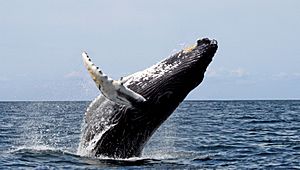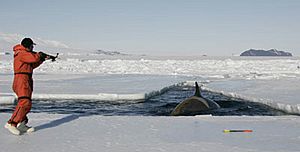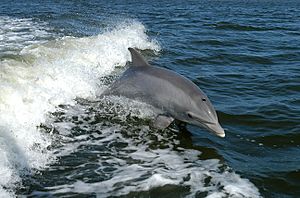Cetology facts for kids
Cetology is a special type of science. It is the study of amazing ocean animals called cetaceans. These include all kinds of whales, dolphins, and porpoises.
Scientists who study cetaceans are called cetologists. They want to understand everything about these animals. This includes how they grew over time, where they live, what their bodies look like, and how they act. They also study how cetaceans live together in groups.
Contents
How Scientists Study Whales and Dolphins

Studying cetaceans can be tricky! Whales and dolphins spend most of their time underwater. They only come to the surface for a short time to breathe. This means scientists don't see much of their behavior on the surface.
Also, cetaceans don't leave tracks like land animals. So, it's hard to know if they have been in an area. However, sometimes whale poop floats. Scientists can collect it to learn about what whales eat. This also helps them understand how whales affect their ocean home. Often, studying cetaceans means a lot of patient waiting and watching.
Cetologists use special tools to help them. They use hydrophones to listen to the sounds whales and dolphins make. They also use binoculars and cameras to watch and photograph the animals from far away. They take many notes about what they see.
Another way to study cetaceans is by looking at dead animals. Sometimes, whales or dolphins wash up on the shore. If these animals are collected carefully, they can give scientists important information. This information is often hard to get when studying live animals in the ocean.
Identifying Individual Whales

In recent years, scientists have found ways to tell individual cetaceans apart. This helps them count how many animals are in a group. It also helps them learn about their lives and how they live together.
One very successful way is called photo-identification. A scientist named Michael Bigg helped make this method popular for studying orcas. In the 1970s, he and Graeme Ellis took many photos of orcas in British Columbia. They soon realized they could recognize individual whales. They looked at the shape and condition of the dorsal fin (the fin on their back). They also looked at the white or gray patch behind the fin, called the saddle patch.
These markings are like a human fingerprint. No two whales have exactly the same ones! Once they could identify individual whales, they learned that orcas travel in stable family groups called pods. Researchers still use photo-identification today to track specific whales and their pods.
This photo method also works well for humpback whale studies. Scientists look at the color patterns on their pectoral fins (side fins). They also look at the unique patterns on the underside of their tail, called the fluke. Scars from orca attacks on the flukes of humpbacks are also used to identify them.
Images for kids
See also
 In Spanish: Cetología para niños
In Spanish: Cetología para niños



